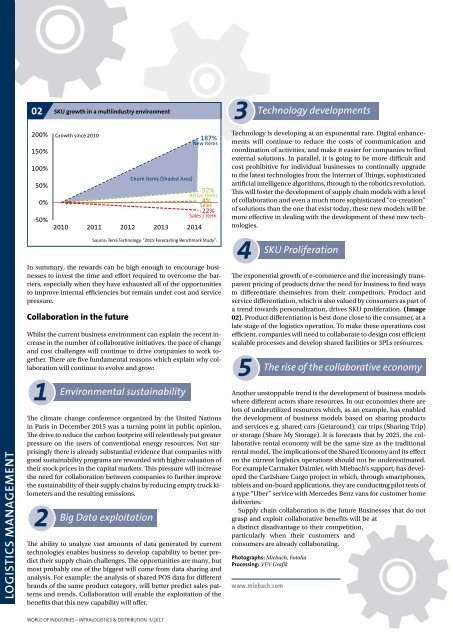WORLD OF INDUSTRIES - LOGISTICS 3/2017
WORLD OF INDUSTRIES - LOGISTICS 3/2017
WORLD OF INDUSTRIES - LOGISTICS 3/2017
- TAGS
- logistics
- intralogistics
You also want an ePaper? Increase the reach of your titles
YUMPU automatically turns print PDFs into web optimized ePapers that Google loves.
<strong>LOGISTICS</strong> MANAGEMENT<br />
02<br />
200%<br />
150%<br />
100%<br />
50%<br />
0%<br />
-50%<br />
SKU growth in a multiindustry environment<br />
Active Items<br />
0%<br />
4%<br />
Sales<br />
In summary, the rewards can be high enough to encourage businesses<br />
to invest the time and effort required to overcome the barriers,<br />
especially when they have exhausted all of the opportunities<br />
to improve internal efficiencies but remain under cost and service<br />
pressure.<br />
Collaboration in the future<br />
187%<br />
32%<br />
-22%<br />
Source: Terra Technology. “2015 Forecasting Benchmark Study”.<br />
Whilst the current business environment can explain the recent increase<br />
in the number of collaborative initiatives, the pace of change<br />
and cost challenges will continue to drive companies to work together.<br />
There are five fundamental reasons which explain why collaboration<br />
will continue to evolve and grow:<br />
1<br />
The climate change conference organized by the United Nations<br />
in Paris in December 2015 was a turning point in public opinion.<br />
The drive to reduce the carbon footprint will relentlessly put greater<br />
pressure on the users of conventional energy resources. Not surprisingly<br />
there is already substantial evidence that companies with<br />
good sustainability programs are rewarded with higher valuation of<br />
their stock prices in the capital markets. This pressure will increase<br />
the need for collaboration between companies to further improve<br />
the sustainability of their supply chains by reducing empty truck kilometers<br />
and the resulting emissions.<br />
2<br />
Growth since 2010<br />
Churn Items (Shaded Area)<br />
2010 2011 2012 2013 2014<br />
Environmental sustainability<br />
Big Data exploitation<br />
New items<br />
Sales / Item<br />
The ability to analyze vast amounts of data generated by current<br />
technologies enables business to develop capability to better predict<br />
their supply chain challenges. The opportunities are many, but<br />
most probably one of the biggest will come from data sharing and<br />
analysis. For example: the analysis of shared POS data for different<br />
brands of the same product category, will better predict sales patterns<br />
and trends. Collaboration will enable the exploitation of the<br />
benefits that this new capability will offer.<br />
3<br />
Technology is developing at an exponential rate. Digital enhancements<br />
will continue to reduce the costs of communication and<br />
coordination of activities, and make it easier for companies to find<br />
external solutions. In parallel, it is going to be more difficult and<br />
cost prohibitive for individual businesses to continually upgrade<br />
to the latest technologies from the Internet of Things, sophisticated<br />
artificial intelligence algorithms, through to the robotics revolution.<br />
This will foster the development of supply chain models with a level<br />
of collaboration and even a much more sophisticated “co-creation”<br />
of solutions than the one that exist today, these new models will be<br />
more effective in dealing with the development of these new technologies.<br />
4<br />
The exponential growth of e-commerce and the increasingly transparent<br />
pricing of products drive the need for business to find ways<br />
to differentiate themselves from their competitors. Product and<br />
service differentiation, which is also valued by consumers as part of<br />
a trend towards personalization, drives SKU proliferation. (Image<br />
02). Product differentiation is best done close to the consumer, at a<br />
late stage of the logistics operation. To make these operations cost<br />
efficient, companies will need to collaborate to design cost efficient<br />
scalable processes and develop shared facilities or 3PLs resources.<br />
5<br />
Another unstoppable trend is the development of business models<br />
where different actors share resources. In our economies there are<br />
lots of underutilized resources which, as an example, has enabled<br />
the development of business models based on sharing products<br />
and services e.g. shared cars (Getaround), car trips (Sharing Trip)<br />
or storage (Share My Storage). It is forecasts that by 2025, the collaborative<br />
rental economy will be the same size as the traditional<br />
rental model. The implications of the Shared Economy and its effect<br />
on the current logistics operations should not be underestimated.<br />
For example Carmaker Daimler, with Miebach’s support, has developed<br />
the Car2share Cargo project in which, through smartphones,<br />
tablets and on-board applications, they are conducting pilot tests of<br />
a type “Uber” service with Mercedes Benz vans for customer home<br />
deliveries.<br />
Supply chain collaboration is the future Businesses that do not<br />
grasp and exploit collaborative benefits will be at<br />
a distinct disadvantage to their competition,<br />
particularly when their customers and<br />
consumers are already collaborating.<br />
Photographs: Miebach, Fotolia<br />
Processing: VFV Grafik<br />
www.miebach.com<br />
Technology developments<br />
SKU Proliferation<br />
The rise of the collaborative economy<br />
<strong>WORLD</strong> <strong>OF</strong> <strong>INDUSTRIES</strong> – INTRA<strong>LOGISTICS</strong> & DISTRIBUTION 3/<strong>2017</strong>
















